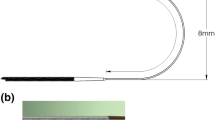Abstract
Purpose
Patients undergoing left atrial ablation require transseptal puncture, which can be challenging, even for experienced physicians. This study compared the efficacy and safety of radiofrequency (RF) energy transseptal punctures to conventional approach.
Methods
Patients requiring transseptal puncture for left atrial access were included using either conventional approach or the NRG™ RF transseptal needle as first attempt. Procedure time for transseptal access, fluoroscopy time, crossover, and safety of both techniques were compared.
Results
A total of 241 transseptal punctures were performed in 148 consecutive patients (114 men, 54 ± 10 years, left atrial volume 32 ± 10 ml/m2) who underwent 157 procedures with left atrial access, mainly for atrial fibrillation. It was a repeat transseptal procedure in 49 patients. Procedures were guided by transesophageal echocardiography. RF transseptal puncture was planned in 119 procedures. RF was delivered in 98 procedures (82%) for 139/187 punctures: 48 punctures did not require RF, including 25 punctures performed by exposing the needle tip, 22 through patent foramen ovale, and 1 RF delivery failure by the generator. Average time for RF transseptal was 4.8 ± 2.8 min compared to 7.5 ± 8.5 min for conventional approach (p = 0.045). Fluoroscopy time was 1.8 ± 1.3 min for RF transseptal and 2.9 ± 2.8 min for standard approach (p = 0.043). Four patients required crossover to RF transseptal needle in the conventional group (p = 0.003). One tamponade occurred at the end of procedure in a patient using the RF needle, and one interatrial septum dissection with aortic root hematoma occurred in the conventional group.
Conclusions
Transseptal needle puncture using RF energy can be performed safely and quickly under imaging guidance.

Similar content being viewed by others
Abbreviations
- AF:
-
Atrial fibrillation
- ICE:
-
Intracardiac echocardiography
- PFO:
-
Patent foramen ovale
- RF:
-
Radiofrequency energy
- TEE:
-
Transesophageal echocardiography
- VT:
-
Ventricular tachycardia
References
Cope, C. (1959). Technique for transseptal catheterization of the left atrium: preliminary report. The Journal of Thoracic Surgery, 37(4), 482–486.
Ross, J., Braunwald, E., & Morrow, A. G. (1959). Transseptal left atrial puncture: new technique for the measurement of left atrial pressure in man. The American Journal of Cardiology, 3(5), 653–655.
Babaliaros, V. C., Green, J. T., Lerakis, S., Lloyd, M., & Block, P. C. (2008). Emerging applications for transseptal left heart catheterization. Old techniques for new procedures. Journal of the American College of Cardiology, 51, 2116–2122.
Sakata, Y., & Feldman, T. (2005). Transcatheter creation of atrial septal perforation using a radiofrequency transseptal system: novel approach as an alternative to transseptal needle puncture. Catheterization and Cardiovascular Interventions, 64(3), 327–332.
Bidart, C., Vaseghi, M., Cesario, D. A., Mahajan, A., Fujimura, O., Boyle, N. G., et al. (2007). Radiofrequency current delivery via transseptal needle to facilitate septal puncture. Heart Rhythm, 4(12), 1573–1576.
Casella, M., Dello Russo, A., Pelargonio, G., Martino, A., De Paulis, S., Zecchi, P., et al. (2008). Fossa ovalis radiofrequency perforation in a difficult case of conventional transseptal puncture for atrial fibrillation ablation. Journal of Interventional Cardiac Electrophysiology, 21(3), 249–253.
Knecht, S., Jais, P., Nault, I., Wright, M., Matsuo, S., Madaffari, A., et al. (2008). Radiofrequency puncture of the fossa ovalis for resistant transseptal access. Circulation: Arrhythmia and Electrophysiology, 1(3), 169–174.
McWilliams, M. J., & Tchou, P. (2009). The use of a standard radiofrequency energy delivery system to facilitate transseptal puncture. Journal of Cardiovascular Electrophysiology, 20, 238–240.
Capulzini, L., Paparella, G., Sorgente, A., de Asmundis, C., Chierchia, G. B., Sarkozy, A., et al. (2010). Feasibility, safety, and outcome of a challenging transseptal puncture facilitated by radiofrequency energy delivery: a prospective single-centre study. Europace, 12, 662–667.
Sherman, W., Lee, P., Hartley, A., & Love, B. (2005). Transatrial septal catheterization using a new radiofrequency probe. Catheterization and Cardiovascular Interventions, 66(1), 14–17.
Shah, D. P., & Knight, D. P. (2010). Transseptal catheterization using a powered radiofrequency transseptal needle. Journal of Interventional Cardiac Electrophysiology, 27(1), 15–16.
Smelley, M. P., Shah, D. P., Weisberg, I., Kim, S. S., Lin, A. C., Beshai, J. F., et al. (2010). Initial experience using a radiofrequency powered transseptal needle. Journal of Cardiovascular Electrophysiology, 21(4), 423–427.
Veldtman, G. R., Wilson, G. J., Peirone, A., Hartley, A., Estrada, M., Norgard, G., et al. (2005). Radiofrequency perforation and conventional needle percutaneous transseptal left heart access: pathological features. Catheterization and Cardiovascular Interventions, 65(4), 556–563.
Champagne, J., Echahidi, N., Philippon, F., St-Pierre, A., Molin, F., Blier, L., et al. (2007). Usefulness of transesophageal echocardiography in the isolation of pulmonary veins in the treatment of atrial fibrillation. Pacing and Clinical Electrophysiology, 30, S116–S119.
Marcus, G. M., Ren, X., Tseng, Z. H., Badhwar, N., Lee, B. K., Lee, R. J., et al. (2007). Repeat transseptal catheterization after ablation for atrial fibrillation. Journal of Cardiovascular Electrophysiology, 18(1), 55–59.
Roelke, M., Smith, A. J., & Palacios, I. F. (1994). The technique and safety of transseptal left heart catheterization: The Massachusetts General Hospital experience with 1,279 procedures. Catheterization and Cardiovascular Diagnosis, 32, 332–339.
Weaver, J. C. (1993). Electroporation: a general phenomenon for manipulating cells and tissues. Journal of Cellular Biochemistry, 51, 426–435.
Whittaker, P., Zheng, S., Patterson, M. J., Kloner, R. A., Daly, K. E., & Hartman, R. A. (2000). Histologic signatures of thermal injury: applications in transmyocardial laser vascularization and radiofrequency ablation. Lasers in Surgery and Medicine, 27, 305–318.
Shah, A. J., Janes, R., Holliday, J., & Thakur, R. (2010). Radiofrequency transseptal catheter electrode fracture. Pacing and Clinical Electrophysiology, 33(6), e57–e58.
Disclosures
The authors declare that they have no conflicts of interest.
Author information
Authors and Affiliations
Corresponding author
Rights and permissions
About this article
Cite this article
Fromentin, S., Sarrazin, JF., Champagne, J. et al. Prospective comparison between conventional transseptal puncture and transseptal needle puncture with radiofrequency energy. J Interv Card Electrophysiol 31, 237–242 (2011). https://doi.org/10.1007/s10840-011-9564-2
Received:
Accepted:
Published:
Issue Date:
DOI: https://doi.org/10.1007/s10840-011-9564-2




